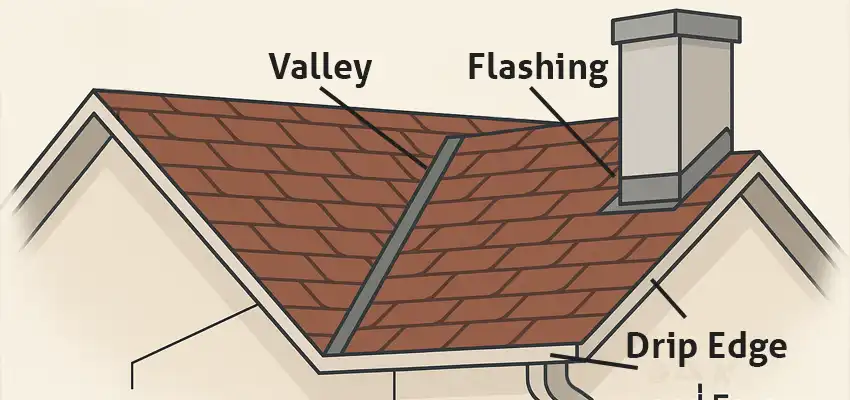Typical trouble spots on an older roof involve shingles and flashing. But if you want to get specific about it, the most vulnerable zones on an older roof are the valleys, drip edges, and where flashing meets walls, chimneys, or dormers. These high stress junctions are vulnerable to water, wind, and seasonal changes, resulting in leaks or deterioration. Today we’ll talk about what to look out for in each area, why they fail, and when to call in a roofer in Hanson MA https://www.reveredroofing.com/hanson-roofing.php.
Flashing
This is the thin sheet metal installed around roof penetrations, such as chimneys, vents, and walls. Flashing can also be installed at areas of transitions, such as gable ends and hips. The purpose is to divert water away from vulnerable joints. However, with time and the weather, flashing can fail. Here’s why:
- Corrosion and rust — Metal flashing can degrade in harsh climates.
- Sealant cracks or shrinkage — When the caulk, mastic, or sealant used at flashing joints or edges starts to harden, crack, or separate, water can get in.
- Thermal movement stress — Expansion and contraction degrades flashing and dislodges edges.
- Improper overlaps or fastener placement — Poorly-overlapped flashing pieces can invite water intrusion.
Valleys
Roof valleys are where two slopes converge, and they often accumulate water. Early signs of wear include:
- Flashing gaps, buckling, or absence — These can lead to a leak risk.
- Debris accumulation — Leaves, needles, and branches settle in valleys, blocking the flow of water and causing rot.
- Ice dam formation — These force water under shingles and flashing in valleys, particularly if you have poor insulation or ventilation.
- Improper valley style or installation — Older roofs feature woven or closed valleys without proper flashing backing or nailing that goes through the flashing itself.
Drop Edges and Eaves
The roof’s perimeter needs drip edge flashing to direct water off the roof without compromising underlayment or roofing materials. Areas of vulnerability include:
- Missing or warped drip edge — Metal can start to deform or detach with time, or it may have been removed during a prior repair. In both cases, water can get underneath.
- Rot or damage to fascia and soffit — Water can cause decay to the supporting boards or fascia.
- Ice buildup at edges — Water can re-freeze under the edge flashing and pry materials loose.
- Improper installation or sealant lapses — If flashing is installed after the shingles are, waterproofing can be compromised.
Older Roofs: What to Watch For
Be on the lookout for:
- Cracked, missing, or hardened sealant around chimneys, walls, and transitions.
- Nails should be located outside active water paths, and flashing should lie flush with no gaps or buckling.
- The drip edge should be firmly secured rather than bent or missing. It should also overlap shingles and underlayment properly.
- Make sure flashing is centered and intact; look for signs of corrosion or movement.
- Look for moisture stains, rot, or mold near flashing, valleys, or eaves inside the attic.
Shingles may get all the attention, but be aware of weaknesses affecting the flashing, valleys, and edges of your roof. Maintaining them will prevent leaks, rot, and costly interior damage.
Contact Revered Metal Roofing
A roofing inspection in Hanson MA https://www.reveredroofing.com/hanson-roofing.php will reveal any damage to the flashing, valleys, and edges of your roof. Just contact us https://www.reveredroofing.com/contact-us.php at 781-536-4589 for a free consultation and quote.
We serve the entire South Shore and lower Cape with quality metal roofing products; standing seam, metal shingle and metal panel roofs in Hanson, Taunton, Marshfield, Quincy, Needham, Medfield, Milton, Halifax, Hanover, Falmouth and Plymouth.
Paul was easy going and a pleasure to deal with. No pressure. Crew got started late but the metal roof with new sky lights over our sun room was done in a day! Quality work. I recommend Revered Metal Roofing.

